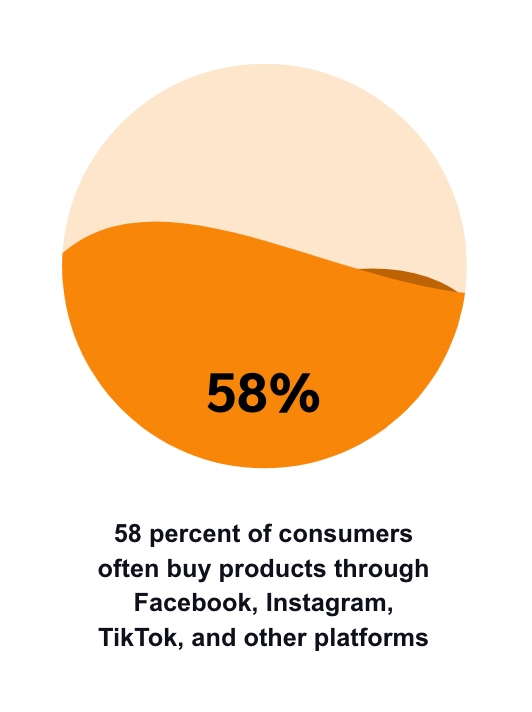Many brands face a consumer trust challenge nowadays: only three percent of shoppers view ads as the most reliable source of info when planning a purchase. Generic advertising strategies are struggling to win over people online. Meanwhile, authentic recommendations and referrals are proving themselves as fantastic marketing channels for increasing customer trust and engagement.
In fact, a new impact.com report on Australian Referral Marketing shows that these recommendations, reviews, and referrals are important factors for over 80 percent of shoppers. With impact.com’s data-driven insights and reward strategies, you’ll grow your referral programs and turn your top customers into thriving, trusted partners.

Six ways to level up your referral programs with smart customer outreach and rewards
Here are six key points from the Australian Referral Marketing Report to kick your referral program into high gear:
1. Focus on social media shoppers [especially millennials and Gen Z)
Shopping online is becoming the norm, with 95 percent of respondents now buying in-store AND online. In fact, five percent even report shopping online exclusively.
While building your brand’s web store is crucial, many brands aren’t keeping up with the rising social media shopping trend. But to reach your target audience, you’ll need to invest and show up where they spend time. Focus on making shopping seamless and easy through your posts, short-form videos, and brand accounts.
- 58 percent of consumers often buy products through Facebook, Instagram, TikTok, and other platforms—with 26 percent making purchases on social media at least once a month.
- Millennials (28-43 years old) reported the highest number with 73 percent. Gen Z isn’t far behind with 68 percent shopping through social media regularly.

2. Drive your referral program with updated incentives instead of setting rewards in stone
Rewarding your shoppers for sharing referral links and recommendations is a win-win strategy. You’ll establish lasting relationships with your customers AND reach potential new converts. Forward-thinking brands have proved how successful these programs can be:
- 41 percent of survey respondents currently take part in referral programs.
- The 36 to 43-year-old demographic participates in these programs the most (with the numbers dropping off substantially after age 44).
These excited customers are clear about why they love referral programs: the rewards.
- 77 percent of consumers reported sharing referrals for brand incentives and rewards.
- Of those people, 49 percent send out referral codes several times yearly. Most of them have earned rewards from the same brands two or three times.
These customers can be incredible marketing partners, sharing your links and discounts with new audiences and like-minded shoppers who are aligned with your brand’s products, values, and style. However, make sure you regularly reevaluate and finely tune your incentives.
- 28 percent of respondents ranked low rewards as their biggest frustration with referral programs.
Your program’s rewards shouldn’t be static. Instead, ask for feedback and track referral rates to find the sweet spot.
3. Create sustainable reward progression instead of one-time bonuses
Smart reward tiers will keep shoppers engaged and invested in your program’s success. No surprise, but cash is the top reward cited by 56 percent of respondents to encourage ongoing recommendations. Here’s how the report’s findings break down:
- 37 percent of consumers said the value should be between 21 and 40 dollars.
- A further 31 percent would be satisfied with between one and 20 dollars.
- Finally, more respondents (22 percent) considered 40 to 60 dollars as an adequate reward for successful referrals.
Many brands use free products to introduce shoppers to new and complementary products and encourage repeat referrals and purchases in addition to (or as an alternate option) cash rewards.
- The next most popular reward is free products and services with 41 percent reporting.
Rewards don’t have to be one-sided, either. A strong focus on shared rewards (for both sides of each successful referral) shows customers how crucial they are for your brand’s success. It’s also easy to keep the referral momentum going as new customers are incentivized to share your products immediately.
- 61 percent of consumers want both parties to receive rewards.
Want to keep your program fun and engaging for long-time customers? Set up a reward exchange program that allows customization to suit a consumer’s preferences. For example, by making multiple successful referrals, participants earn points that they can cash in and select their own rewards. This approach also gives referrers more autonomy and ownership of the process.
4. Encourage happy customers to share recommendations with people they know
Trust is crucial for many shoppers—especially with AI-generated images, fraudulent reviews, and other factors in mind. When referrals are coming from people in your circle, potential customers are more likely to finish the purchase. Here’s what the new report shows:
- 81 percent of consumers rated recommendations and referrals highly in their buying decisions
- 84 percent make purchases based on referrals and recommendations from someone they know.
Millennial shoppers are particularly influenced by tips and reviews from peers.
- 91 percent of those aged 28-35 say they value referrals from someone they know when making first-time purchases.

5. Encourage relevant referrals over generic brand recommendations
While personal referrals are a fantastic way to build consumer trust, these programs aren’t one-size-fits-all. Some potential customer demographics are more likely to share recommendations:
- Out of the 59 percent of respondents who don’t participate in referral programs, most were aged 44 and older.
- 49 percent of those nonparticipants said they avoid referrals because they don’t want to annoy people.
This is why relevant referrals make a huge difference. Recommendations feel natural and seamless when products align perfectly with a shopper’s style and interests. Instead of annoying people with generic promotions, encourage your customers to contact other shoppers with matching interests.
6. Keep each step in the referral process transparent and secure
Customers overwhelmingly named data privacy as a referral program’s most important feature. Brands should always keep this point in mind—staying vigilant against leaks or excessive data requests.
- 76 percent of respondents indicated data privacy was very (or extremely) important for referral programs.
Keep referral programs straightforward, and always explain why you’re asking for each data point. Based on this survey, shoppers were most likely to participate in a referral program when they were only required to submit an email address to receive their link or code. So remember to keep the process simple and ensure your customers know how much you value their data safety.
FAQ
To convert customers into brand advocates, engage with millennials and Gen Z on social media platforms like Facebook, Instagram, and TikTok, encouraging them to share personal recommendations. Offer dynamic incentives, such as cash or free products, to keep participants interested and engaged. Prioritize data privacy by keeping data collection simple and transparent, building trust, and encouraging participation in referral programs.
Drive brand advocacy by creating customizable referral programs that align with your strategic goals, using platforms like impact.com/advocate to offer meaningful rewards. Utilize advanced tracking to optimize program performance and ensure it resonates with your audience. Engage stakeholders with data-driven insights, presenting a compelling business case that highlights the cost-effectiveness and potential revenue boosts of referral marketing.
Using real-world data to build successful referral partnerships
Referral programs aren’t just about short-term gains. This channel offers a sustainable way to grow momentum and brand awareness over time as each customer shares why they love your products.
With feedback from real customers on your side, you’ll avoid the common pitfalls holding back many brand’s referral programs. As online shopping trends evolve, you can rely on in-depth research like impact.com’s newest report to set yourself up for success.
To learn more, you can read impact.com’s full Australian Referral Marketing Report here.




